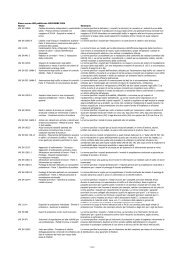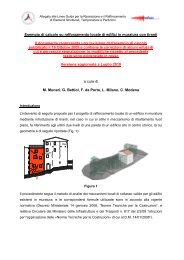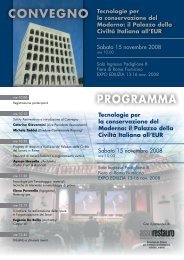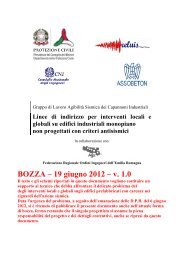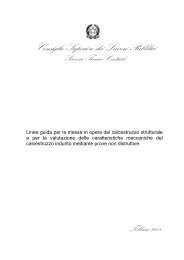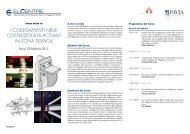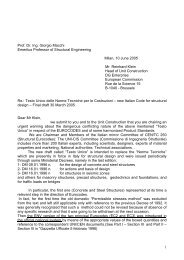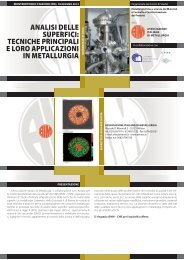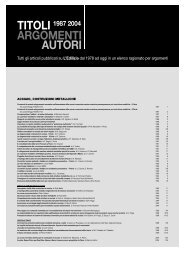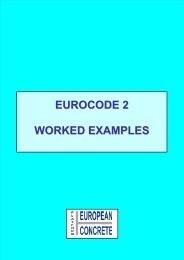Combinazioni di Verifica agli stati Limite: il non ... - Steelchecks.com
Combinazioni di Verifica agli stati Limite: il non ... - Steelchecks.com
Combinazioni di Verifica agli stati Limite: il non ... - Steelchecks.com
Create successful ePaper yourself
Turn your PDF publications into a flip-book with our unique Google optimized e-Paper software.
23<br />
2 G2 Permanente (carichi portati)<br />
3 V1 Variab<strong>il</strong>e “V” (prima scacchiera)<br />
4 V2 Variab<strong>il</strong>e “V” (seconda scacchiera)<br />
5 V3 Variab<strong>il</strong>e “V”(carichi pieni)<br />
6 R1 Variab<strong>il</strong>e “R”<br />
7 W1 Variab<strong>il</strong>e “W” (vento x)<br />
8 W2 Variab<strong>il</strong>e “W” (vento y)<br />
9 W3 Variab<strong>il</strong>e “W” (vento +45°)<br />
10 W4 Variab<strong>il</strong>e “W” (vento –45°)<br />
11 T1 Variab<strong>il</strong>e “T” (termico + 25°C)<br />
12 T2 Variab<strong>il</strong>e “T” (termico –25°C)<br />
13 E1 Accidentale “E” (sisma X)<br />
14 E2 Accidentale “E” (sisma Y)<br />
15 E3 Accidentale “E” (sisma +45°)<br />
16 E4 Accidentale “E” (sisma –45°)<br />
17 S1 Variab<strong>il</strong>e “S” (neve su metà copertura)<br />
18 S2 Variab<strong>il</strong>e “S” (neve su altra metà copertura)<br />
19 S3 Variab<strong>il</strong>e “S” (neve su tutta la copertura)<br />
E la seguente matrice <strong>di</strong> contemporaneità (si noti la <strong>non</strong> contemporaneità del riscaldamento con la<br />
neve):<br />
Caso<br />
3<br />
V1<br />
Caso<br />
4<br />
V2<br />
Caso<br />
5<br />
V3<br />
Caso<br />
6<br />
R1<br />
Caso<br />
7<br />
W1<br />
Caso<br />
8<br />
W2<br />
Caso<br />
9<br />
W3<br />
Caso 3 V1 1 0 0 1 1 1 1 1 1 1 1 1 1 1 1 1 1<br />
Caso 4 V2 0 1 0 1 1 1 1 1 1 1 1 1 1 1 1 1 1<br />
Caso 5 V3 0 0 1 1 1 1 1 1 1 1 1 1 1 1 1 1 1<br />
Caso 6 R 1 1 1 1 1 1 1 1 1 1 1 1 1 1 1 1 1<br />
Caso 7 W1 1 1 1 1 1 0 0 0 1 1 1 1 1 1 1 1 1<br />
Caso 8 W2 1 1 1 1 0 1 0 0 1 1 1 1 1 1 1 1 1<br />
Caso 9 W3 1 1 1 1 0 0 1 0 1 1 1 1 1 1 1 1 1<br />
Caso 10 W4 1 1 1 1 0 0 0 1 1 1 1 1 1 1 1 1 1<br />
Caso 11 T1 1 1 1 1 1 1 1 1 1 0 1 1 1 1 0 0 0<br />
Caso 12 T2 1 1 1 1 1 1 1 1 0 1 1 1 1 1 1 1 1<br />
Caso 13 E1 1 1 1 1 1 1 1 1 1 1 1 0 0 0 1 1 1<br />
Caso 14 E2 1 1 1 1 1 1 1 1 1 1 0 1 0 0 1 1 1<br />
Caso 15 E3 1 1 1 1 1 1 1 1 1 1 0 0 1 0 1 1 1<br />
Caso 16 E4 1 1 1 1 1 1 1 1 1 1 0 0 0 1 1 1 1<br />
Caso 17 S1 1 1 1 1 1 1 1 1 0 1 1 1 1 1 1 0 0<br />
Caso 18 S2 1 1 1 1 1 1 1 1 0 1 1 1 1 1 0 1 0<br />
Caso 19 S3 1 1 1 1 1 1 1 1 0 1 1 1 1 1 0 0 1<br />
Caso<br />
10<br />
W4<br />
Caso<br />
11<br />
T1<br />
Caso<br />
12<br />
T2<br />
Caso<br />
13<br />
E1<br />
Caso<br />
14<br />
E2<br />
Caso<br />
15<br />
E3<br />
Caso<br />
16<br />
E4<br />
Caso<br />
17<br />
S1<br />
Caso<br />
18<br />
S2<br />
Caso<br />
19<br />
S3<br />
I risultati che si ottengono per le <strong>com</strong>binazioni degli <strong>stati</strong> limite ultimi sono i seguenti:<br />
Tenendo in conto<br />
Numero<br />
<strong>com</strong>binazioni<br />
Contemporaneità 457<br />
Contemporaneità + segni 913<br />
Contemporaneità + segni+ inf/sup sui permanenti 3507<br />
Contemporaneità + segni+ inf/sup sui permanenti+inf/sup sui variab<strong>il</strong>i 11422<br />
5 HAL9000<br />
I risultati presentati mostrano con plastica evidenza che gli algoritmi previsti dalle norme<br />
europee attualmente in vigore, se applicati con coerenza, portano a dover considerare un numero <strong>di</strong><br />
<strong>com</strong>binazioni così alto da escludere in modo categorico, anche per le strutture più semplici e per le<br />
Paolo Rugarli – <strong>Combinazioni</strong> <strong>di</strong> <strong>Verifica</strong> <strong>agli</strong> <strong>stati</strong> <strong>Limite</strong>: <strong>il</strong> <strong>non</strong> detto delle Normative



